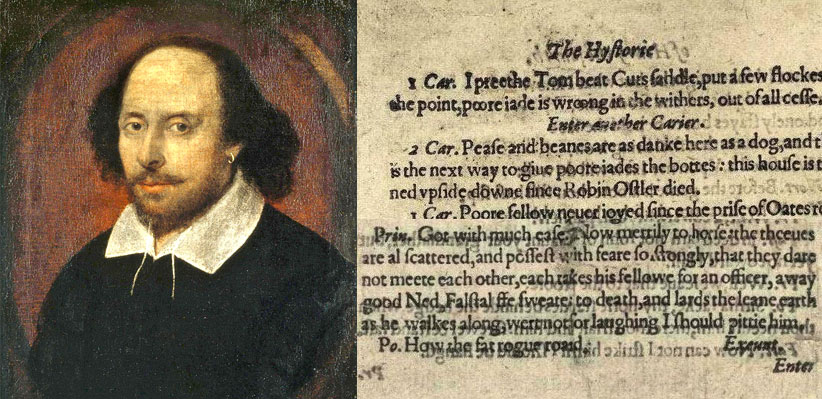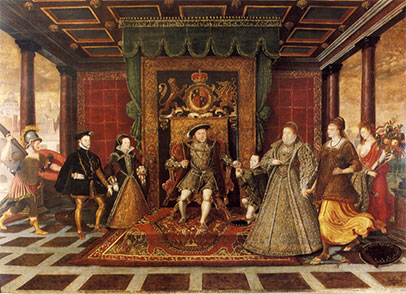 In honor of William Shakespeare we are celebrating the 400th anniversary of his death on April 23, 2016. What better way to do this, than by highlighting the writing done by first-year students in Associate Professor of English John Wesley’s first-year seminar, A Year in the Life of William Shakespeare? This first-year seminar in scholarly inquiry studies four remarkable plays Shakespeare wrote or saw into production in 1599, the same year he opened the Globe Theatre. In the first half of the course, students were introduced to the myriad ways in which Shakespeare’s 1599 plays are shaped by and give shape to the political and cultural intrigues of that year. In the second half of the course, students turned to a play (and year) of their own choosing, the historicist analysis of which is the basis of an independent research project. As part of this project, students were asked to prepare a blog post that reflected on aspects of Shakespeare’s life, a specific work, or a resource or organization associated with Shakespeare, or to provide a personal interpretation of a play. During the month of April, we’ll feature the posts from students that celebrate all things Shakespeare!
In honor of William Shakespeare we are celebrating the 400th anniversary of his death on April 23, 2016. What better way to do this, than by highlighting the writing done by first-year students in Associate Professor of English John Wesley’s first-year seminar, A Year in the Life of William Shakespeare? This first-year seminar in scholarly inquiry studies four remarkable plays Shakespeare wrote or saw into production in 1599, the same year he opened the Globe Theatre. In the first half of the course, students were introduced to the myriad ways in which Shakespeare’s 1599 plays are shaped by and give shape to the political and cultural intrigues of that year. In the second half of the course, students turned to a play (and year) of their own choosing, the historicist analysis of which is the basis of an independent research project. As part of this project, students were asked to prepare a blog post that reflected on aspects of Shakespeare’s life, a specific work, or a resource or organization associated with Shakespeare, or to provide a personal interpretation of a play. During the month of April, we’ll feature the posts from students that celebrate all things Shakespeare!
Congratulations to our wonderful first-year writers. For additional online resources about Shakespeare, check out these sites:
- British Library: http://www.bl.uk/
- Folger Shakespeare Library: http://www.folger.edu/
- Globe Theatre: http://www.shakespearesglobe.com
- Internet Shakespeare Editions: http://internetshakespeare.uvic.ca
- Shakespeare 400: http://www.shakespeare400.org/
Perspectives on Sonnet 55
By Chelsea Bruen
Not marble nor the gilded monuments
Of princes shall outlive this pow’rful rhyme,
But you shall shine more bright in these contents
Than unswept stone, besmeared with sluttish time.
When wasteful war shall statues overturn,
And broils root out the work of masonry,
Nor Mars his sword nor war’s quick fire shall burn
The living record of your memory.
‘Gainst death and all oblivious enmity
Shall you pace forth; your praise shall still find room
Even in the eyes of all posterity
That wear this world out to the ending doom.
So, till the judgment that yourself arise,
You live in this, and dwell in lovers’ eyes.
-William Shakespeare
“Sonnet 55,” by William Shakespeare, is hard to pin down. Some say it’s a love sonnet, because what sonnet wouldn’t be about love? Some look a little closer and think it’s about time. Some, such as myself, try to connect it to history.
Philip McGuire looked a little closer and found the theme of time. In McGuire’s article “Shakespeare’s Non-Shakespearean Sonnets” he speaks to the poem’s theme of time, referencing the unusual rhyme pattern as a way that this poem, “will endure, keeping his beloved alive, until, with final judgement, time itself ceases to be” (McGuire 312). I don’t disagree that Shakespeare deviates from the typical sonnet rhyme pattern, but I think the theme of time runs a bit deeper than rhyme. Overall, I see a questioning of when time will run out and what will remain. Taking phrases such as “outlive”, “sluttish time”, and “living record” together provide an overall experience of moving through time till eventually it runs out (on judgement day), leaving behind only the record (this sonnet) of what occurred.
Helen Vendler also sees the deeper meaning of time. In The Art of Shakespeare’s Sonnets, Vendler describes the frequent use of the word “live” in sonnet 55, and uses it to draw out a central question from the poem, “Does the person [you] remain alive in the contents, or does only a record [of your memory] remain?” (Vendler 268). Vendler’s idea that Shakespeare is questioning which side is the truth is very intriguing; are we alive without a record or only remembered within it? I’m not sure the poem gives an answer to the question she raises, perhaps Shakespeare was struggling with it himself.
The theme of time is in the poem, and it doesn’t include romance. Time is about record and memory and history, not infatuation. Time is something these authors and I agree on, but we do not agree on who Shakespeare is writing about. Vendler and McGuire interpret this person to be a young man, I think it is quite the opposite.
I believe this sonnet is about Queen Elizabeth I. Throughout the poem there are subtle hints that the person he speaks of is someone of great importance, saying that “Not marble nor the gilded monuments / Of princes shall outlive this pow’rful rhyme” (1-2). It can be taken that he means great statues / monuments of royalty will not outlive this rhyme, and also not outlive the memory of who he speaks of, meaning that they are important enough to not be easily forgotten. Elizabeth was a very important person in Shakespeare’s time, you know being Queen and all, but that is not solid evidence that this is about her. These lines are better evidence, “Nor Mars his sword nor war’s quick fire shall burn / The living record of your memory. / ‘Gainst death and all oblivious enmity” (7-9). Mary, Queen of Scots, was associated with Mars god of war (you can see her next to Mars in the painting below). Mary was rumored to be succeeding Elizabeth, and also may have been plotting against Elizabeth. That information fits very well into the lines. I read them to say: Mary can’t destroy your (Elizabeth’s) memory, nor can war, you will live on past this hostility. Bringing it back to the first two lines, Shakespeare may be saying here that Elizabeth’s memory will live on, or Elizabeth herself will.
Elizabeth did live on, well beyond the life expectancy of the times, bringing it back to the theme of time. I think this sonnet is questioning when Elizabeth’s time will run out, and how she will be remembered through history.
Unfortunately, we will never know exactly what this sonnet meant from Shakespeare’s perspective. Looking at the historical references I found in the sonnet anyone could make a case that it’s about Elizabeth, but there are other valid arguments, except love. I see many things in this sonnet, but romance is not one of them.
Bibliography
McGuire, Philip C. “Shakespeare’s Non-Shakespearean Sonnets.” Shakespeare Quarterly 38.3 (1987): 304-319. Web. 01 Mar. 2016.
Shapiro, James. A Year in the Life of William Shakespeare. New York: Harper Perennial, 2005. Print.
Vendler, Helen. The Art of Shakespeare’s Sonnets. Cambridge: Harvard University Press, 1997. Print.
Wagner, John A. and Susan Walter Schmid. “Mary, Queen of Scots.” Encyclopedia of Tudor England. 2011. Web.
“Family of Henry VIII, an Allegory of the Tudor Succession.” Wikimedia Commons. Wikimedia, 15 Jan. 2016. Web. 01 Mar. 2016.

